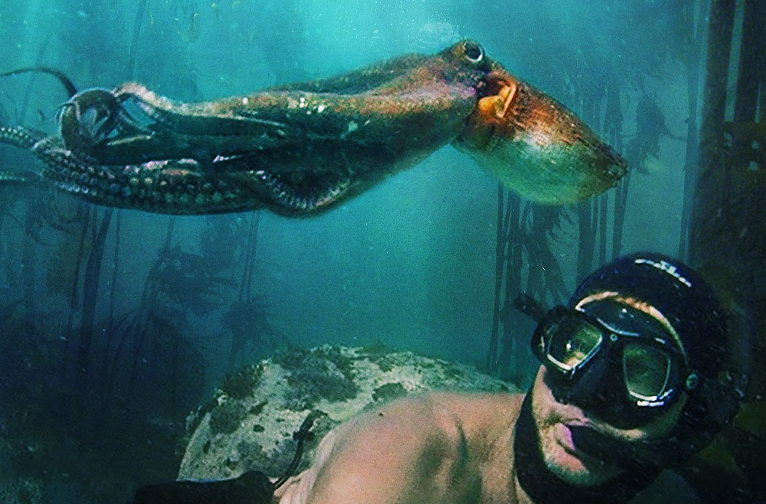My Octopus Teacher
A Netflix Original documentary in association with Off the Fence and The Sea Change Project. Written and directed by Pippa Ehrlich and James Reed; cinematographed by Roger Horrocks; edited by Pippa Ehrlich and Dan Schwalm; music by Kevin Smuts; produced by Craig Foster. Released in Sept 2020. Running time: 85 minutes. Rated TV-G. Starring Craig Foster and Tom Foster
My Octopus Teacher is both a gorgeous wildlife documentary and a moving tale of how a man in crisis found joy and purpose through immersion in nature and a remarkable relationship with an octopus. That man is South African documentary filmmaker Craig Foster. Some years back, Foster’s health and family life were suffering terribly due to his high-stress lifestyle, and he decided to seek solace in a shallow cove he had explored as a child. During one dive, he had a chance encounter with a female octopus, and over the next 11 months he devoted his life to befriending and learning all he could about her. Despite the vast species gap, they developed a special bond.
The first scene beautifully evokes the odd charm of their relationship. We open with a slow aerial tracking shot of an ethereally lit ocean shore. We’re immediately lulled by the music’s lilting chants, the sound of surf breaking against boulders and the faint calls of seagulls. The camera then tracks forward through an aquamarine dreamland of swaying kelp. Eventually we alight on Foster as he roams the seafloor, clad only in trunks, scuba fins, a diving hood and goggles. (In order to be closer to nature, he has foregone a wetsuit and oxygen tanks.) In the next shot, we see him eye-level with the octopus, who timidly remains half-tucked in her rocky den. Her body is considerably smaller than a cat’s, but she is not un-catlike in the way she curiously prods her tentacles at Foster’s bare arm.
Foster is both our main human subject and our narrator. Early on in the film, he describes two formative experiences that prepared him for his time with the octopus. The first was growing up in a wooden bungalow on the shore of the notoriously treacherous Cape of Good Hope. Foster remembers waves so fierce they broke down the bungalow’s doors and flooded the ground floor. This was incredibly exciting to him as a child, and it’s part of what fueled his passion for exploring the ocean. As he recounts these childhood memories, the film makes superb use of reenactments to keep the story visually engaging.
The other key experience in Foster’s personal evolution was the time he and his brother Damon spent filming their first picture, a 2000 documentary titled The Great Dance, which follows the daily life of a bushman in the Kalahari Desert. Foster recollects his amazement at how profoundly attuned the hunter was to his surroundings. He had an uncanny ability to spot wildlife that was invisible to Foster as an outsider. The filmmaker says he felt an intense longing to be inside the natural world in the same way the hunter was. Years later, in his quest to learn about the octopus, Foster would emulate the bushman’s legendary tracking skills.
We then flash forward to Foster’s decision, as a middle-aged man, to rediscover the undersea realm that had enchanted him as a boy. He tells us it was hard for him to get into the water at first, due to both the frigid temperatures (which dip into the upper 40s Fahrenheit) and the rough swells. There was also the fact that, because he was free diving, he had to hold his breath while underwater. But he overcame these challenges and began avidly taking in the strange sights around him in this world he aptly calls “much more extreme than our maddest science fiction.” We see some breathtaking photographs by Foster that amply testify to his sense of otherworldly wonder, revealing creatures as close to extraterrestrial as anything one is likely to find on Earth.
Equally astonishing is Roger Horrocks’ cinematography. Horrocks shows us the minutest details of air bubbles in ocean waves, the delicate ruffles of bright green sea lettuce and the ghostly bioluminescent flashes of jellyfish. Many of these shots are so perfectly composed that they seem painted rather than photographed. Horrocks also mesmerizingly captures the various transformations of the octopus, including one in which she sprouts horns, another in which she seamlessly disguises herself as coral and one of her briskly jogging across the seafloor on two tentacles.
The movie splendidly captures the awe and fascination of Foster’s first meeting with the octopus. When he first sees her, she’s assuming one of her many disguises. “I remember there was this strange shape to my left,” he recalls. The camera then cuts to a heap of seashells that seems to defy gravity in the way it’s arranged. A moment later, the shells topple as the octopus, who has been hiding underneath them, jets off into the distance. We next see her wrapping herself inside a large frond of seaweed—cautiously peeking out at Foster as she does so—before fleeing again. Foster feels a connection during their brief moment of eye contact, which gives rise to what he calls a “crazy idea.” “What happens if I just went every day?” he finds himself wondering. “What happens if I never missed a day?”
So he makes a habit of visiting that same area daily. He takes his time building a rapport with the animal, for though she is fascinated by him, he can tell she is also nervous around him. At first, he just leaves his camera outside her den. We see her gingerly approach it, poking it with one tentacle while shielding herself with a seashell grasped firmly in another. It takes 26 days for her to first shyly reach out to Foster, and even longer for her to fully emerge from her den in his presence. Once she does begin to trust Foster, a whole new world of discovery opens up to both of them. Foster records stunning close-up footage of the myriad forms and colors taken on by this animal whose body is nearly as free-flowing as the water in which she resides. The two begin swimming together, and eventually the creature is hopping onto his arm and chest like a pet eager for strokes.
When not underwater with his new companion, Foster is finding out everything he can about her from the scientific literature. As he relates his findings, we learn a host of mind-bending things about her species, the common octopus (or octopus vulgaris), including the fact that most of her cognition occurs outside her brain. “Her entire being,” rhapsodizes Foster, “is thinking, feeling, exploring.” For her part, the octopus is busy studying Foster, at one point even cleverly incorporating him into her hunting strategy.
One day, Foster accidentally spooks her, causing her to permanently leave her den in search of another. He despairs of ever finding her again. To track her down, he must learn to distinguish octopus tracks from those of other animals, recognize octopus predation marks and think like an octopus. At home, he creates elaborate maps and detective pinboards. In short, he becomes a bushman of the entire kelp forest ecosystem in which the octopus lives.
There are some moments of genuine suspense involving the octopus’ attempts to evade predators. Both we and Foster marvel at the great cunning with which she escapes being eaten by a pajama shark, first by camouflaging herself—and then, when that fails, by climbing onto his back where he can’t reach her. Another shark attack leaves her wounded and Foster feeling guilty about the role he may have played in the incident. He tortures himself with the possibility that he made her vulnerable to attack by distracting her from her surroundings. But she rebounds from her injuries, and her recovery coincides with a period of personal healing in Foster’s life. “In a strange way,” he says, “our lives were mirroring each other.”
The movie’s title is no misnomer: By film’s end, we’re amazed at how much the octopus truly has taught Foster. His time with her has reawoken his dormant passions for photography and the ocean; made him feel sentimental toward animals for the first time; and turned him into an ardent conservationist and amateur zoologist, eventually leading him to cofound an ocean preservation nonprofit known as the Sea Change Project. Moreover, every aspect of his life, from his physical health to his interpersonal dealings, has undergone a terrific revitalization.
The movie offers some ecological insights, but they don’t go especially deep. They’re pretty much limited to a couple of brief comments by Foster on the great diversity and interconnectedness of life within the kelp forest. Still, the feeling, technical mastery and deft storytelling skill that went into this film make it easily worthy of its Best Documentary Feature win at last year’s Academy Awards.
Teaser photo credit: By SeaChangeProject – Own work, CC BY-SA 4.0, https://commons.wikimedia.org/w/index.php?curid=93993491






